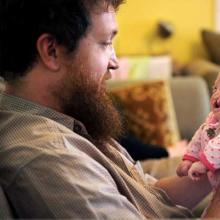Death and Dying
As of April 15, more than 101,000 people worldwide have died of the novel coronavirus. In the U.S., 42 states, the District of Columbia, and Puerto Rico have issued orders for people to stay in their homes to slow the spread. But with at least 1.6 million infected globally, the mortality rate has forced an increasing number of people to confront a topic they tend to otherwise avoid: death.
Her once boundless energy starts to fail by midday. She started radiation treatment on May 21, mainly in an effort to forestall the possible collapse of her spine, which would leave her helpless and in intractable pain.
“That sounds a little formidable to me,” she says.
“I was never much for suffering.”
She goes on, her words carefully chosen. “Am I grateful for this? Not exactly. But I’m not unhappy about it. And that’s very difficult for people to understand.”
None of the remains of the 26 babies — miscarried, stillborn, and short-lived — whose names are engraved on paving stones or metal butterflies at the Remembrance Garden are actually interred there. But to the families who gathered at the memorial last month, the plot is sacred ground.
“The garden says to us: You matter,” Biskup told them.
“Your baby existed. He or she matters. We remember.”
One summer my cousin Betty and I sneaked through the barbed-wire fence of a neighbor’s orchard and ate so many wild plums right off the tree that we almost made ourselves sick. Betty was 13 and I was 9, and I adored her. I still do.
Betty is dying right now. She might not make it till Christmas, which is really bad timing in my opinion. Yes, I talk with God about this. It’s one thing for me to lose a beloved cousin: I’m old enough to know from experience that, while the pain can feel like a raw wound that might never heal, losing those we love is a normal part of life. But I keep wondering, What kind of message is God sending to Betty’s family by jerking her away from them during this holy season of Advent? Doesn’t God care that they are already plunged into grief in anticipation of losing someone they love so much?
Yes, I talk with God about my fears, too, mostly in the form of questions from the little five-year-old kid inside me. What’s going to happen? Where are we going? What will it be like? Will it hurt? Do I have to? And, Why?
Brittany Maynard’s decision to die soon by a legal, lethal prescription, rather than let a brain tumor kill her, has provoked a national conversation and debate about end-of-life decisions.
In a new video, released Oct. 29, she says she feels herself getting sicker by the day. But since she still feels joy in living, she’ll postpone her day of death past the date originally announced — Nov. 1.
Maynard, 29, has inspired raging arguments about the values, even about the vocabulary, underlying the choices we make about our last days. Her goal, she still says, is to “influence this policy (on physician-assisted dying) for positive change.”
As ethicists, activists and religious voices square off, here are five things to know about death and dying.
NASHVILLE, Tenn. -- Eric and Ruth Brown believe nothing about daughter Pearl Joy's life is a mistake.
They say God gave Pearl her bright red hair and wide blue eyes, as well as the genetic disorder that created a cleft in her upper lip and caused her brain's development to stall in the first weeks in the womb.
"Things didn't go wrong," Eric Brown said. "God has designed Pearl the way he wanted, for his glory and our good."
That belief has sustained the Browns during the past six months, ever since a routine ultrasound revealed that the couple's third child has alobar holoprosencephaly, a rare genetic condition that's almost always fatal. A specialist told the Browns she would probably die in the womb and advised them to end the pregnancy early.
It's one thing to talk about God's will when life is good. It's another when a doctor is saying your baby won't live.
The Browns were forced to consider religious, medical and ethical issues most parents never will. And nobody could make their decision for them.
The Browns never considered abortion. They believe that Pearl is "fearfully and wonderfully made," as Psalm 139 puts it, and God alone should decide when she lives and when she dies.
Seeing Pearl's beating heart on the ultrasound also persuaded them to continue the pregnancy, even if the odds were stacked against her.
"If there is a chance, you say yes to that chance," Eric Brown said. "The only thing I know about parenting is that you say yes."
So far, Pearl has beaten the odds.
Few babies with Pearl's disorder make it to term, and of those who do, only 3 percent survive birth, according to the Dallas-based Carter Centers for Brain Research in Holoprosencephaly and Related Malformations. Pearl has a particularly severe form of the condition, which means her brain never divided into two hemispheres.
She turned 11 weeks old Oct. 12, a milestone that the Browns celebrated by lighting 11 candles and singing "Happy Birthday."
One man searches for balance between family and solitude, nature and technology.
I very much appreciated “The Art of Dying” by Lisa Sowle Cahill (June 2010).
In her generally fine article, Lisa Sowle Cahill states, “euthanasia or physician-assisted suicide is not an acceptable answer to the stress of human death.”
Is a proper burial for World Trade Center victims a justice issue? Diane Horning's vigil for the conscience of America.
In Ceremonies of the Seasons, Jennifer Cole writes, “All calendars are founded upon a wish to organize our experience of time into manageable units—especially the year, with i
Making caskets is fine. But who's going to clean up this mess? Inside their light, fragrant workshop, a handful of monks are hard at work. They're planing. They're ripping.
As someone who’s had several deaths in my family, I can testify that prayers and casseroles are both helpful to the grieving process. But they’re not the only things that church people have to offer.
Members and pastors of St. Catherine of Siena parish in Austin, Texas, provide the bereaved with babysitting, transportation help, meals, liturgy planning, accompaniment to the funeral home, a post-funeral reception, bereavement groups, and counseling. Last year parishioners Carole Hawkins, Bob Leidlein, and Cheryl Grossman put together a resource booklet (incorporating materials from the Austin Memorial and Burial Information Society) after having shared their "funeral stories" with one another. They credit Father Oliver Johnson for actively encouraging parishioners to draw from their experiences and create ministries for the whole community.
Grossman is involved in plans for a diocesan-wide conference on the pastoral response to end-of-life issues. "This opens the forum to a large geographic area and a diverse community," she explains. "Folks without many financial or education resources will have access to a wide variety of experience and information."
Cheryl Grossman and her husband used to laugh together about all the "rigmarole" that most funeral services involved. So when he died suddenly in October 1997, Cheryl knew that he would want the arrangements to be simple. Grossman, with a friend to support her, went to a funeral home to arrange a direct cremation. The funeral director kept "upselling"—pressing her to consider more expensive alternatives.
"Had I not had a friend who went with me, and had I not had a firm resolve, I probably would have signed anything," she says. "To be manipulated in that way at that time was one of the most obscene things I’d ever experienced."
Cheryl Grossman’s funeral home encounter is a common one. Not so common is how she took her experience to church—and how her church embraced it. Cheryl’s Catholic parish, St. Catherine of Siena in Austin, Texas, has offered a diverse array of practical and pastoral supports to the grieving for some time. Last year Grossman and two other parishioners helped create a death and funeral resource booklet that gathers information on all applicable parish ministries and other area resources in a convenient portable form. It includes specific information on affordable funeral options, planning sheets, and step-by-step advice for those dealing with a death in the family (see "Reclaiming Our Rites," p. 33).
Such a booklet is a simple, straightforward thing, but not every church would know how to welcome it. Most American Christians, including clergy, are almost as comfortable talking about the practical, concrete details of funerals as they are talking about the practical, concrete details of sex. In other words, the topic doesn’t come up much. And unlike sex, funeral planning isn’t a hot topic outside of church either.







